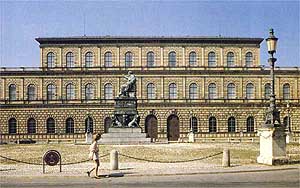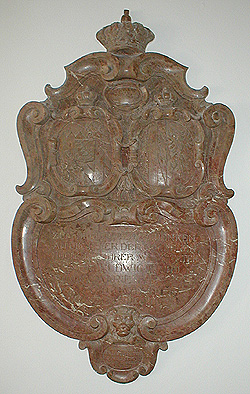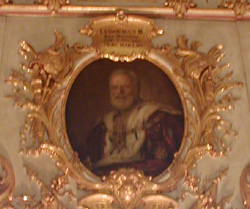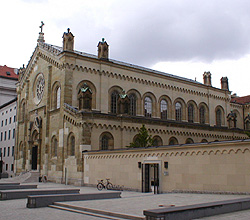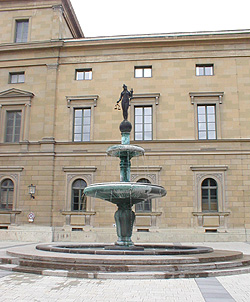 |
 |
 |
 |
 |
 |
 |
 |
 |
|
A Jacobite Gazetteer - Bavaria
Munich - Residenz |
The Residenz is a huge palace complex located in central Munich. It was formerly the official residence of the kings of Bavaria. After the death of her husband King Francis I, Queen Adelgunde lived part of each year in this palace with her brother Prince Regent Luitpold of Bavaria. 1 Queen Mary IV and III and her husband King Ludwig III of Bavaria lived in the palace for a short period in 1916 and 1917. 2 The building was severely damaged by bombing during World War II. Much of the structure which one sees today is the result of post-war rebuilding. Many of the paintings, furniture, and interior fittings, however, had all been removed from the palace before the bombing, and have now been restored to their original locations. The Residence Museum located in the south-west corner of the palace contains most of the former state-rooms. Separate parts of the palace are open in the mornings and the afternoons (with a few rooms open all day). One most follow a set route; in order to see all the rooms of interest, one must visit in both the morning and the afternoon. |
On the morning tour when one can visit the Charlottengang, one can see just to its west the Wide Staircase (Breite Treppe). This staircase is used as the formal entry into the palace from the Fountain Courtyard (Brunnenhof). On the landing of the staircase is a red marble tablet commemorating the Golden Wedding Anniversary of Queen Mary IV and III and her husband King Ludwig III of Bavaria in 1918. The tablet is about a metre wide and almost two metres high, and has the following inscription:
|
On the second floor in a gallery just before one comes to the Hofkapelle is a display about the Order of St. George; it includes the shields of King Rupert and of King Ludwig III of Bavaria. Just past the Hofkapelle is a long narrow gallery decorated with a number of sets of antlers, several of which were shot by King Ludwig III of Bavaria. In the Ahnengalerie (at the end of the morning tour, and the beginning of the afternoon tour) there are portraits of important members of the House of Wittelsbach; the portrait of King Ludwig III of Bavaria , husband of Queen Mary IV and III is on the left wall, just past the middle of the room, in the topmost of the three tiers. There are several throne rooms in the palace. In one of these there are two thrones, one of which has the initial "L" embroidered on it (for King Ludwig III of Bavaria), while the other has the initial "M" embroidered on it (for his wife Queen Mary IV and III). The Treasury (Schatzkammer) also contains a number of items of interest. In Room I is a medieval crown which belonged to Anne of Bohemia, wife of King Richard II. 3 In Room V are displayed the nineteenth-century crown jewels of Bavaria. In a cabinet on the left is displayed a knee buckle of the Order of the Garter which belonged to the Elector Palatine Friedrich V (the "Winter King of Bohemia"), son-in-law of King James I and VI. In the next cabinet is the pearl diadem, necklace, and earrings worn in official portraits by Queen Antonia, second wife of King Rupert. At the far end of Room X is a travelling set which belonged to King Francis I. 4 At his death it passed to his niece Queen Mary IV and III; in 1959 it was sold to the Bavarian State government. Also in the palace but in a room not open to the public are portraits of Queen Mary IV and III (1917) and of her husband King Ludwig III of Bavaria (1918) by Walter Thor. 5 |
On the east side of the palace (south of the Cuvillies Theatre and the Kabinettsgarten) is the site of the Court Church of All Saints (Allerheiligenhofkirche); this is not the same as the Hofkapelle which can be seen on the morning tour of the Residenz. Here in 1842 King Francis I married Princess Adelgunde of Bavaria, and in 1900 the Duke of Cornwall and Rothesay (later King Rupert) married Duchess Marie Gabriele in Bavaria. The church was almost totally destroyed by bombing in 1944; its re-construction was not completed until 2003. |
A fountain erected in honour of King Rupert stands in the Marstallplatz on the east side of the Residenz outside the entrance to the Bayerischen Akademie der Wissenschaften (the Bavarian Academy of Sciences and Humanities). 6 The fountain was designed by Bernhard Bleeker 7 and was unveiled May 18, 1961. 8 The fountain is made of Eifel-basalt, while the steps are made of Würzburg limestone. Rising above the centre of the fountain is a crowned female figure holding a pair of scales in her right hand (symbolizing justice) and a statue of the goddess Athena in her left hand (symbolizing science and art). On the fountain is an inscription: "Kronprinz Rupprecht von Bayern zum Gedenken" (In memory of Crown Prince Rupert of Bavaria). There is a similar fountain (but without the statue of Athena) in front of Schloss Berchtesgaden. The Residenz Museum is open daily 9:00 a.m. - 6:00 p.m. (entrance € 4,00). Telephone: 089.290671. Notes 1 Elena Bianchini Braglia, Adelgonda di Baviera: L'ultimo duchessa di Modena, Reggio, Massa e Carrara (Modena: Edizioni Terra e Identità, 2004), 158. 2 Hubert Glaser, Ludwig III. König von Bayern: Skizzen aus seiner Lebensgeschichte (Prien: Verkehrsverband Chiemsee, 1995), 70. 3 Richard II was succeeded (de facto) by King Henry IV. Henry's daughter, Blanche, married the Elector Palatine Ludwig III in 1402, and brought the crown as part of her dowry. 4 The travelling set was originally presented by the City of Paris in 1810 to the Archduchess Marie Louise of Austria on the occasion of her marriage to Napoleon Bonaparte. When Marie Louise died, it was inherited by King Francis I (who also received the Duchy of Guastalla from Marie Louise). 5 Hans F. Schweers, Gemälde in deutschen Museen: Katalog der ausgestellten und depotgelagerten Werke, 2nd edition (München: K.G. Saur, 1994), I, 4, 1870. The portraits are each 88 cm X 64 cm. Walter Thor was born in 1870 in Neusalz an der Oder, and died in 1929 in Munich. 6 King Rupert was named an Honorary Member of the academy in 1911. King Francis II was named an Honorary Member of the academy in 1999. 7 Bernhard Bleeker was born at Münster in 1881; he died at Munich in 1968. He completed a number of commissions for the Royal Family. In 1910 he sculpted a bust of King Rupert's grandfather, Prince Regent Luitpold of Bavaria. In 1917 he designed the King Ludwig Medal for Science and Art. In 1952 he sculpted a bust of King Rupert's father, King Ludwig III of Bavaria. 8 Otto Josef Bistritzki, Brunnen in München: Lebendiges Wasser in einer großen Stadt (München: Georg D. W. Callwey, 1974), 78. Image 1 (South Facade): unknown source. Image 2 (Marriage Anniversary Tablet): © Noel S. McFerran 2005. Image 3 (King Ludwig III of Bavaria): © Noel S. McFerran 2005. Image 4 (Allerheiligenhofkirche): © Noel S. McFerran 2005. Image 5 (Kronprinz-Rupprecht-Brunnen): © Noel S. McFerran 2005.
This page is maintained by Noel S. McFerran (noel.mcferran@rogers.com) and was last updated June 6, 2005. |
